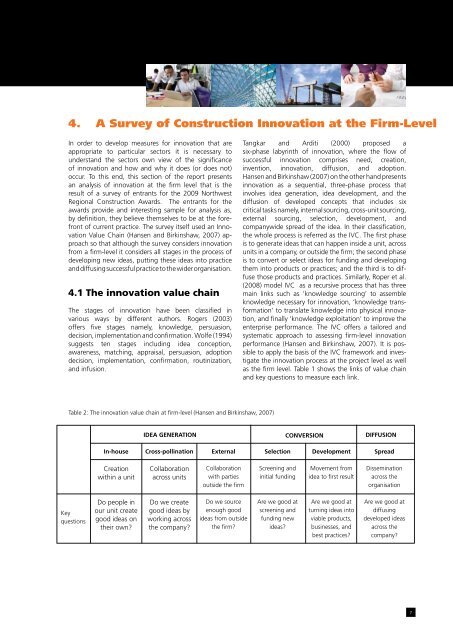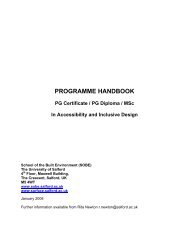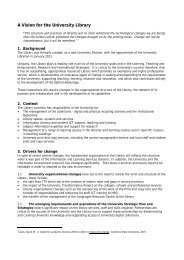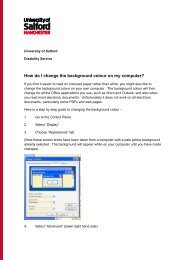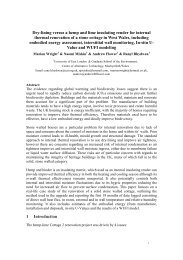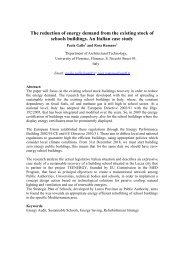Innovation in Construction A Project Life Cycle Approach
Innovation in Construction A Project Life Cycle Approach
Innovation in Construction A Project Life Cycle Approach
Create successful ePaper yourself
Turn your PDF publications into a flip-book with our unique Google optimized e-Paper software.
4. A Survey of <strong>Construction</strong> <strong>Innovation</strong> at the Firm-LevelIn order to develop measures for <strong>in</strong>novation that areappropriate to particular sectors it is necessary tounderstand the sectors own view of the significanceof <strong>in</strong>novation and how and why it does (or does not)occur. To this end, this section of the report presentsan analysis of <strong>in</strong>novation at the firm level that is theresult of a survey of entrants for the 2009 NorthwestRegional <strong>Construction</strong> Awards. The entrants for theawards provide and <strong>in</strong>terest<strong>in</strong>g sample for analysis as,by def<strong>in</strong>ition, they believe themselves to be at the forefrontof current practice. The survey itself used an <strong>Innovation</strong>Value Cha<strong>in</strong> (Hansen and Birk<strong>in</strong>shaw, 2007) approachso that although the survey considers <strong>in</strong>novationfrom a firm-level it considers all stages <strong>in</strong> the process ofdevelop<strong>in</strong>g new ideas, putt<strong>in</strong>g these ideas <strong>in</strong>to practiceand diffus<strong>in</strong>g successful practice to the wider organisation.4.1 The <strong>in</strong>novation value cha<strong>in</strong>The stages of <strong>in</strong>novation have been classified <strong>in</strong>various ways by different authors. Rogers (2003)offers five stages namely, knowledge, persuasion,decision, implementation and confirmation. Wolfe (1994)suggests ten stages <strong>in</strong>clud<strong>in</strong>g idea conception,awareness, match<strong>in</strong>g, appraisal, persuasion, adoptiondecision, implementation, confirmation, rout<strong>in</strong>ization,and <strong>in</strong>fusion.Tangkar and Arditi (2000) proposed asix-phase labyr<strong>in</strong>th of <strong>in</strong>novation, where the flow ofsuccessful <strong>in</strong>novation comprises need, creation,<strong>in</strong>vention, <strong>in</strong>novation, diffusion, and adoption.Hansen and Birk<strong>in</strong>shaw (2007) on the other hand presents<strong>in</strong>novation as a sequential, three-phase process that<strong>in</strong>volves idea generation, idea development, and thediffusion of developed concepts that <strong>in</strong>cludes sixcritical tasks namely, <strong>in</strong>ternal sourc<strong>in</strong>g, cross-unit sourc<strong>in</strong>g,external sourc<strong>in</strong>g, selection, development, andcompanywide spread of the idea. In their classification,the whole process is referred as the IVC. The first phaseis to generate ideas that can happen <strong>in</strong>side a unit, acrossunits <strong>in</strong> a company, or outside the firm; the second phaseis to convert or select ideas for fund<strong>in</strong>g and develop<strong>in</strong>gthem <strong>in</strong>to products or practices; and the third is to diffusethose products and practices. Similarly, Roper et al.(2008) model IVC as a recursive process that has threema<strong>in</strong> l<strong>in</strong>ks such as ‘knowledge sourc<strong>in</strong>g’ to assembleknowledge necessary for <strong>in</strong>novation, ‘knowledge transformation’to translate knowledge <strong>in</strong>to physical <strong>in</strong>novation,and f<strong>in</strong>ally ‘knowledge exploitation’ to improve theenterprise performance. The IVC offers a tailored andsystematic approach to assess<strong>in</strong>g firm-level <strong>in</strong>novationperformance (Hansen and Birk<strong>in</strong>shaw, 2007). It is possibleto apply the basis of the IVC framework and <strong>in</strong>vestigatethe <strong>in</strong>novation process at the project level as wellas the firm level. Table 1 shows the l<strong>in</strong>ks of value cha<strong>in</strong>and key questions to measure each l<strong>in</strong>k.Table 2: The <strong>in</strong>novation value cha<strong>in</strong> at firm-level (Hansen and Birk<strong>in</strong>shaw, 2007)IDEA GENERATIONCONVERSIONDIFFUSIONIn-houseCross-poll<strong>in</strong>ationExternalSelectionDevelopmentSpreadCreationwith<strong>in</strong> a unitCollaborationacross unitsCollaborationwith partiesoutside the firmScreen<strong>in</strong>g and<strong>in</strong>itial fund<strong>in</strong>gMovement fromidea to first resultDissem<strong>in</strong>ationacross theorganisationKeyquestionsDo people <strong>in</strong>our unit creategood ideas ontheir own?Do we creategood ideas bywork<strong>in</strong>g acrossthe company?Do we sourceenough goodideas from outsidethe firm?Are we good atscreen<strong>in</strong>g andfund<strong>in</strong>g newideas?Are we good atturn<strong>in</strong>g ideas <strong>in</strong>toviable products,bus<strong>in</strong>esses, andbest practices?Are we good atdiffus<strong>in</strong>gdeveloped ideasacross thecompany?7


